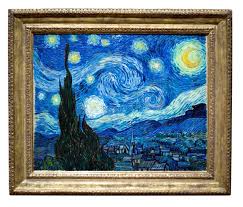Unveiling "The Starry Night" by Vincent van Gogh: History, Symbolism, and Enduring Influence
Vincent van Gogh's "The Starry Night" is a timeless masterpiece that has captivated art enthusiasts and inspired countless interpretations since its creation in 1889. This iconic painting is a part of the collection at the Museum of Modern Art in New York City and remains one of the most recognized and cherished works in the world of art. In this blog, we will take a closer look at the history, composition, and the profound impact of "The Starry Night."
1. Historical Context
"The Starry Night" was painted by Vincent van Gogh during his stay at the Saint-Paul-de-Mausole asylum in Saint-Rémy-de-Provence, France. At this time, Van Gogh was struggling with his mental health, which adds depth to the painting's emotional intensity. The view from his window served as the primary inspiration for the artwork.
2. Composition and Style
Van Gogh's distinctive style, characterized by bold colors and dramatic brushwork, is fully expressed in "The Starry Night." The painting features a small village with steeples and houses in the foreground, nestled beneath a swirling, turbulent sky. The stars and crescent moon dominate the night sky, their radiant light contrasting with the deep blues and swirling patterns.
The cypress tree in the foreground, with its twisted and elongated branches, adds a unique sense of movement and drama to the composition. Its dark silhouette reaches towards the sky, connecting the earthly scene with the celestial one.
3. Symbolism and Interpretations
"The Starry Night" is rife with symbolism and has been interpreted in various ways. Some suggest that the swirling patterns in the sky represent Van Gogh's inner turmoil, while others see them as a manifestation of his spiritual and emotional connection to the universe. The radiant stars and moon have also been associated with hope and light in the darkness of his troubled mind.
The cypress tree has been interpreted as a symbol of death and resurrection, given its association with cemeteries and the idea of spiritual rebirth. The village beneath the swirling sky could be seen as a place of refuge and stability amid chaos.
4. Influence on Art
"The Starry Night" has had a profound influence on the art world and continues to inspire artists, writers, and filmmakers. Its swirling composition and emotional depth have made it a symbol of both artistic innovation and the human struggle.
Many artists have paid homage to Van Gogh's masterpiece through their own works, while popular culture has incorporated "The Starry Night" into various forms, from fashion to advertising. This enduring popularity underscores the painting's universal appeal.
Conclusion
Vincent van Gogh's "The Starly Night" is more than just a painting; it's a window into the artist's turbulent mind and a testament to the power of art to convey complex emotions and ideas. Its unique composition, rich symbolism, and enduring influence continue to make it a beloved and thought-provoking masterpiece in the world of art. The painting reminds us that even in the darkest of times, there is beauty and inspiration to be found in the night sky.








Comments
Post a Comment